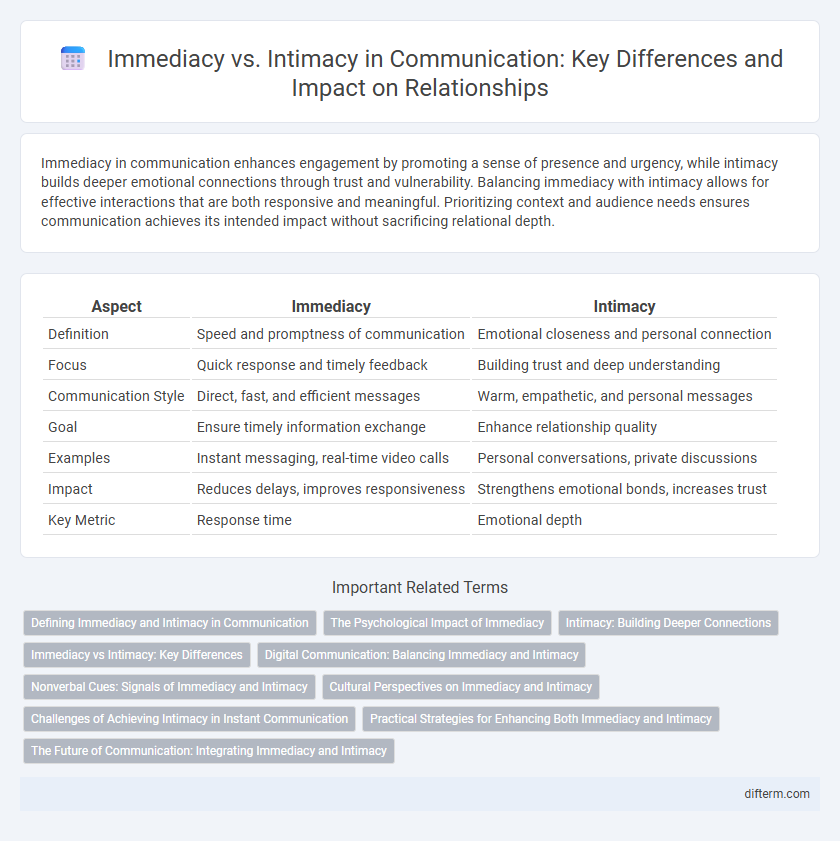Immediacy in communication enhances engagement by promoting a sense of presence and urgency, while intimacy builds deeper emotional connections through trust and vulnerability. Balancing immediacy with intimacy allows for effective interactions that are both responsive and meaningful. Prioritizing context and audience needs ensures communication achieves its intended impact without sacrificing relational depth.
Table of Comparison
| Aspect | Immediacy | Intimacy |
|---|---|---|
| Definition | Speed and promptness of communication | Emotional closeness and personal connection |
| Focus | Quick response and timely feedback | Building trust and deep understanding |
| Communication Style | Direct, fast, and efficient messages | Warm, empathetic, and personal messages |
| Goal | Ensure timely information exchange | Enhance relationship quality |
| Examples | Instant messaging, real-time video calls | Personal conversations, private discussions |
| Impact | Reduces delays, improves responsiveness | Strengthens emotional bonds, increases trust |
| Key Metric | Response time | Emotional depth |
Defining Immediacy and Intimacy in Communication
Immediacy in communication refers to behaviors that enhance physical or psychological closeness between individuals, such as eye contact, forward body posture, and vocal expressiveness. Intimacy involves a deeper emotional connection characterized by self-disclosure, trust, and mutual understanding. Both immediacy and intimacy play crucial roles in building rapport and strengthening relational bonds in interpersonal communication.
The Psychological Impact of Immediacy
Immediacy in communication fosters psychological closeness by reducing emotional distance and enhancing feelings of warmth and trust between individuals. Nonverbal cues such as eye contact, body orientation, and vocal expressiveness significantly increase perceived immediacy, which can boost engagement and decrease social anxiety. This immediacy effect plays a crucial role in therapeutic settings, education, and interpersonal relationships by facilitating openness and improving relational satisfaction.
Intimacy: Building Deeper Connections
Intimacy in communication fosters deeper emotional connections by encouraging vulnerability, active listening, and empathy. Establishing trust through consistent and meaningful interactions enhances relational depth beyond surface-level exchanges. This profound connection promotes openness, mutual understanding, and long-term relationship satisfaction.
Immediacy vs Intimacy: Key Differences
Immediacy in communication refers to behaviors that enhance physical or psychological closeness, such as eye contact and body language, aimed at creating a sense of presence and engagement. Intimacy, however, involves deeper emotional connections and trust established over time through self-disclosure and vulnerability. Understanding the key differences between immediacy and intimacy helps improve communication effectiveness by balancing momentary closeness with sustained personal bonds.
Digital Communication: Balancing Immediacy and Intimacy
Digital communication demands balancing immediacy, characterized by rapid message exchanges, with intimacy, which fosters deeper emotional connections. Platforms like instant messaging and video calls provide real-time interaction but risk reducing nuanced understanding, while slower methods like emails offer reflective intimacy at the expense of speed. Optimizing digital conversations requires integrating timely responsiveness with personalized, empathetic content to enhance meaningful relationships.
Nonverbal Cues: Signals of Immediacy and Intimacy
Nonverbal cues such as eye contact, body orientation, and touch serve as powerful signals of immediacy, enhancing the sense of psychological closeness between communicators. These behaviors promote intimacy by conveying warmth, engagement, and emotional connection without words. Proxemics and facial expressions further reinforce the level of intimacy, making nonverbal communication essential in building and maintaining close interpersonal relationships.
Cultural Perspectives on Immediacy and Intimacy
Cultural perspectives heavily influence communication styles regarding immediacy and intimacy, with high-context cultures often valuing indirect expressions of closeness and nonverbal cues to foster intimacy. In contrast, low-context cultures tend to prioritize explicit verbal communication and immediate responsiveness to establish and maintain relational closeness. Understanding these cultural differences enhances intercultural communication effectiveness by aligning immediacy behaviors with culturally appropriate expressions of intimacy.
Challenges of Achieving Intimacy in Instant Communication
Instant communication platforms prioritize speed and convenience, often at the expense of developing deep emotional connections, creating challenges in achieving true intimacy. The absence of nonverbal cues and delayed feedback limits the ability to convey empathy and nuanced feelings, hindering authentic interpersonal bonds. Overcoming these barriers requires intentional effort to balance rapid exchanges with meaningful, thoughtful dialogue to foster genuine closeness.
Practical Strategies for Enhancing Both Immediacy and Intimacy
Practical strategies for enhancing immediacy and intimacy in communication include using consistent eye contact, mirroring body language, and engaging in active listening to foster trust and connection. Employing personalized verbal affirmations and responsive feedback creates a sense of closeness while maintaining the flow of interaction. Incorporating appropriate touch and reducing physical barriers further strengthens immediate presence and emotional intimacy in both personal and professional contexts.
The Future of Communication: Integrating Immediacy and Intimacy
The future of communication hinges on seamlessly integrating immediacy, characterized by real-time interactions enabled by technologies like 5G and AI-driven messaging, with intimacy, which fosters deeper emotional connections through personalized content and empathetic interfaces. Emerging platforms leverage augmented reality (AR) and virtual reality (VR) to create immersive experiences that combine instant responsiveness with meaningful social presence. This fusion transforms digital communication by enhancing authenticity, trust, and engagement across personal and professional networks.
immediacy vs intimacy Infographic

 difterm.com
difterm.com